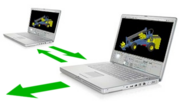Difference between revisions of "Open collaborative design/Intro"
| (177 intermediate revisions by the same user not shown) | |||
| Line 1: | Line 1: | ||
| − | [[ | + | [[image:Open_design_two_notebooks.png|right|180px]] '''Open collaborative design''' involves applying principles from the remarkable [[free and open-source software]] movement that provides a powerful new way to design physical objects, machines and systems. All information involved in creating the object or system is made available on the Internet {{en}} such as text, drawings, photographs and 3D [[Free and open-source computer-aided design/What is computer-aided design|computer-aided design]] (CAD) models {{en}} so that other people can freely re-create it, or help contribute to its further evolution. It is essentially the same principle that is used to progress scientific knowledge, however in reality it is much more open and transparent than much of contemporary scientific research. |
| − | + | A core element of this development model is a principle called {{wp|Copyleft|'copyleft'}} (symbol: [[Image:Copyleft.png|12px]]) which is a way of applying copyright to a creative work in a way that makes sure that ''anyone'' can freely use it or build upon it - and also that derivative works inherit the same terms, ensuring anything based on the original is freely available too. This principle means that 'copylefted' items {{en}} whether they are designs, text, artwork or computer code {{en}} are effectively gifted to humanity, adding to an ever increasing universal 'commons'. Because this principle is to the benefit of everyone, it completely changes the way that many people think about contributing their time and effort to this type of project. It already works very effectively with many high profile, successful [[Free and open-source software|software projects]], so this is not merely wishful thinking. | |
| + | |||
| + | Open collaborative design is a nascent field that has huge potential to radically alter the way we create goods, machines and systems {{en}} not only for personal items but all the way up to components of national or global infrastructure. | ||
Latest revision as of 21:16, 2 January 2012
Open collaborative design involves applying principles from the remarkable free and open-source software movement that provides a powerful new way to design physical objects, machines and systems. All information involved in creating the object or system is made available on the Internet – such as text, drawings, photographs and 3D computer-aided design (CAD) models – so that other people can freely re-create it, or help contribute to its further evolution. It is essentially the same principle that is used to progress scientific knowledge, however in reality it is much more open and transparent than much of contemporary scientific research.A core element of this development model is a principle called 'copyleft'  (symbol:
(symbol: ![]() ) which is a way of applying copyright to a creative work in a way that makes sure that anyone can freely use it or build upon it - and also that derivative works inherit the same terms, ensuring anything based on the original is freely available too. This principle means that 'copylefted' items – whether they are designs, text, artwork or computer code – are effectively gifted to humanity, adding to an ever increasing universal 'commons'. Because this principle is to the benefit of everyone, it completely changes the way that many people think about contributing their time and effort to this type of project. It already works very effectively with many high profile, successful software projects, so this is not merely wishful thinking.
) which is a way of applying copyright to a creative work in a way that makes sure that anyone can freely use it or build upon it - and also that derivative works inherit the same terms, ensuring anything based on the original is freely available too. This principle means that 'copylefted' items – whether they are designs, text, artwork or computer code – are effectively gifted to humanity, adding to an ever increasing universal 'commons'. Because this principle is to the benefit of everyone, it completely changes the way that many people think about contributing their time and effort to this type of project. It already works very effectively with many high profile, successful software projects, so this is not merely wishful thinking.
Open collaborative design is a nascent field that has huge potential to radically alter the way we create goods, machines and systems – not only for personal items but all the way up to components of national or global infrastructure.
